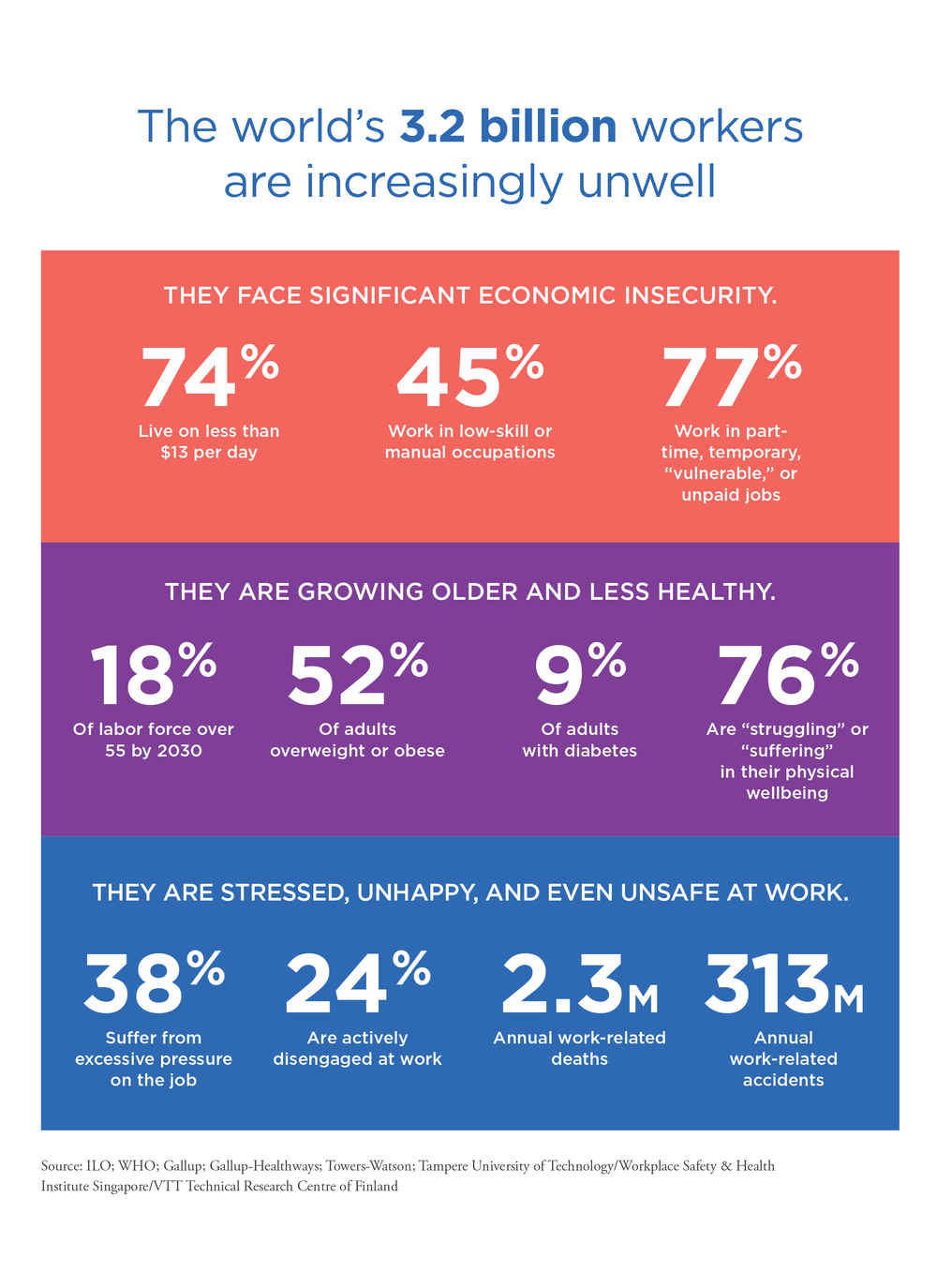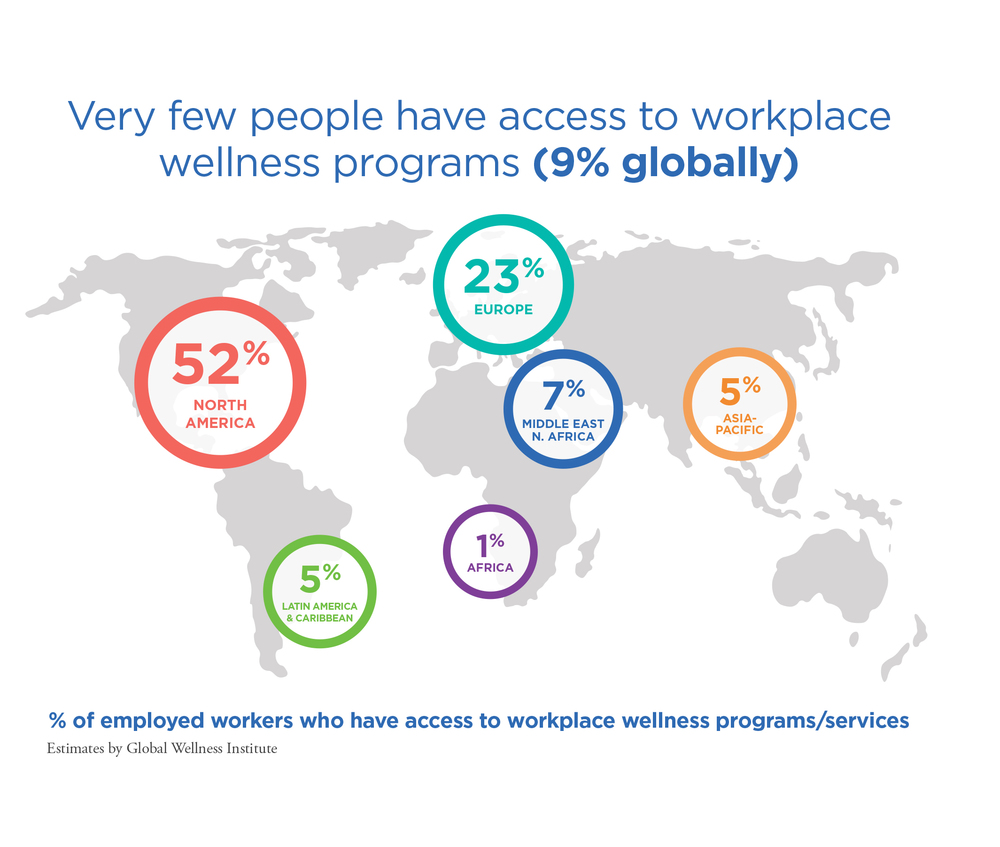Media Contact: Beth McGroarty
[email protected]• +1.213.300.0107
Global Wellness Institute Releases Report and Survey on
‘The Future of Wellness at Work’
Research reveals that it’s not wellness programs that boost worker health and productivity –
it’s whether employees identify that company as genuinely “caring”;
New approaches needed as unwellness at work now costs the U.S. $2.2 trillion annually, or 12% of GDP
New York, NY – February 17, 2016 – Today at a unique press event at Steelcase headquarters in Manhattan, the Global Wellness Institute (GWI) released two companion pieces of research. The first, “The Future of Wellness at Work”, offers in-depth analysis of the state of unwellness in the global workforce and workplace wellness approaches worldwide and in the U.S. – and forecasts the many ways that work and workplace wellness concepts will change dramatically in the future. Access the 80-page report here.
The second, a white paper on findings from a GWI/Everyday Health survey of full-time American employees (“Unlocking the Power of Company Caring”), gauges how employees feel about many aspects of their work culture and wellness programs. The overwhelming finding: to understand what has the most powerful impact on employee wellness you must look well beyond the wellness “program.” Instead, the pivotal factor was whether an employee identified their company as “caring about their health/wellness,” and when they did, their overall health, stress levels and job engagement improved significantly. The report then analyzes the tangible and intangible elements that constitute “company caring,” and have the biggest impact on employee wellness, finding they differ significantly for Millennial, Gen X and Baby Boomer employees.
“The findings surprised us: we saw significant, diverse and positive implications when a company is perceived to “care” about an employee’s personal wellness, and extremely negative outcomes when it was perceived as a “non-caring” company,” said Global Wellness Institute Chairman & CEO Susie Ellis. “And we found that caring companies tackle not just ‘tangibles’ like healthy food and workspaces, they address emotional, relational, organizational, intellectual and financial ‘wellness’ at work (whether it’s giving workers more work flexibility or encouraging socializing and friendships).”
Ellis noted that being a company that “cares” is easier than management may think. And while intangible “work culture” components may seem elusive, the research shows that they are the true drivers of health and productivity – according to employees. Both studies reach the same conclusion: the current, compartmentalized “programmatic” approaches to workplace wellness will disappear in the future, and companies will reorient their wellness strategies around culture-wide “caring,” paying close attention to what that means for their particular workforce.
Key Findings:
THE GLOBAL WORKER IN UNWELL
Most of the world’s 3.4 billion workers are unwell. They live with serious economic insecurity: 74% make less than $13/day; 45% are in low-skill/manual jobs; 77% are in part-time or unstable jobs. They’re aging at an historic rate: 18% of the workforce will be over 55 by 2030. They’re unhealthy: 52% are overweight/obese, and 76% report they’re struggling with their wellbeing.

High resolution graphs from the report available for download at this link.
WELLNESS PROGRAMS REACH LESS THAN ONE IN TEN WORKERS WORLDWIDE
Only 9% of the global workforce has access to some form of wellness program at work. The breakdown in penetration: North America 52% of employees, Europe 23%, Middle East/North Africa 7%, Latin America/Caribbean 5%, Asia 5% and Sub-Saharan Africa 1%. The U.S., where companies pay for employee healthcare, is by far the largest market and innovator, but as chronic disease skyrockets globally, and healthcare costs (paid via taxes) spike in markets like Europe, the GWI predicts significant growth in global workplace wellness spending in the next decade.

High resolution graphs from the report available for download
at this link.
COST OF WORKER UNWELLNESS? UNSUSTAINABLE
Worldwide, the cost of unwell workers represents 10-15% of global economic output. The GWI estimates that in the U.S., when you tally the cost of employees’ chronic disease ($1.1 tril.), work-related injuries/illnesses ($250 bil.), work-related stress ($300 bil.) and the cost of work disengagement ($550 bil.) that an unhealthy workforce costs the nation $2.2 trillion a year, or a staggering 12% of GDP.
High resolution graphs from the report available for download
at this link.
WORK TO CHANGE RADICALLY: FROM INFORMATION TO “WISDOM” ECONOMY
The GWI report forecasts the many ways that work will change in the future. Hierarchical management structures will be replaced by models giving employees greater autonomy and accountability. Long-term, stable jobs (at set locations/hours) will give way to an increasingly virtual and “free agent” workforce. As older workers retire later, the workforce will be intensely multigenerational: by 2020 teens and employees over 70 will work side-by-side. The most profound shift: the Information Age will be succeeded by a “Wisdom” or “Human” Age: as robots and Artificial Intelligence coopt many work tasks, qualities not replicable by machines (collaboration, creativity, empathy, constant learning, etc.) will be in high demand. And these qualities demand the highest level of mental and physical wellness.
High resolution graphs from the report available for download at this link.
WELLNESS PROGRAMS: LITTLE IMPACT & LOW ENGAGEMENT
Fifty-four percent of full-time American workers have a workplace wellness program, but only 40% of employees with programs say they actually improve their health/wellness; nearly one-third don’t use them; and 10% don’t even know if one is available. And the impact of programs is marginal across age groups: for Gen X and Boomer workers, 58% of those with a program rate their health/wellness high, vs. 42% without one. Millennials report that the presence of a workplace wellness program makes zero difference: 50% rate their health/wellness high with and without a program.
CYNICISM ABOUT WELLNESS PROGRAMS ABOUNDS
Only 25% of employees believe that their company offers a wellness program because they care about workers’ health and wellbeing. Fifty-eight percent believe their program exists only to cut company health costs, while another 17% believe it’s in place to make employees work harder/be more productive. So, 3 in 4 employees are now cynical, perceiving wellness programs as companies “caring” more about their bottom-line than employee health.
WHEN COMPANIES “CARE” EMPLOYEE HEALTH, STRESS & ENGAGEMENT SIGNIFICANTLY IMPROVED
The survey data clearly indicates that to understand what has the most profound impact on employee wellness, you need to look beyond the existence of wellness programs. The critical finding: if an employee identified their company as “caring about their health/wellness”* (and a disturbingly low 37% did), that employee’s overall health, stress and job engagement/satisfaction improved significantly. For example:
- Fifty-seven percent of employees at “caring” companies rate their health/wellness high, vs. only 39% at “non-caring” companies. Only 8% at caring companies report poor personal health, vs. 21% at non-caring companies.
- Only 17% of employees at caring companies report “very high” stress vs. 41% at non-caring ones.
Employees at caring companies are dramatically more engaged: more than twice as likely to report their work satisfying (52% vs. 25%), exciting (33% vs.16%), and interesting (66% vs. 30%) – and that “they’re proud to be associated with the company” (68% vs. 19%).
WHAT DEFINES A “CARING” COMPANY? THE TANGIBLES
The white paper identifies dozens of tangible offerings (whether healthy workspace design or formal wellness programs) that comprise a “caring” vs. “non-caring” company – according to employees. Among “tangibles,” compensation, benefits and recognition impact worker wellness most. Those that work for non-caring companies are 11 times more likely to report that their pay, benefits and recognition have a negative impact on their wellness. And caring companies are more likely to offer financial counseling (39%) than the uncaring (17%), as well as non-monetary gifts/incentives (64% vs. 30%).
Caring companies are also more likely to provide employees with a wellness program than the non-caring (67% vs. 41%) – and encourage/offer a host of healthy options, like regular exercise (58% vs. 20%), healthy eating (57% vs. 21%), meditation (20% vs. 7%), stress reduction (35% vs. 13%), mental health services (56% vs. 34%), and wellness coaching (38% vs. 24%.)
“CARING” & HEALTHY WORKSPACES
Eighty-three percent of employees at caring companies (vs. 48% at uncaring) report they have comfortable workspaces. And workers at caring companies are significantly less likely to report that lack of break time/space (15% vs. 48% for uncaring) – fresh air (17% vs. 45%) – or private space (19% vs. 38%) are detractors from their health and productivity. Caring companies are also significantly more likely to offer healthy workspace elements: like providing nap/meditation spaces (33% vs. 13%), standing treadmill desks (23% vs. 11%), or places for moms to breastfeed (38% vs. 18%).
COMPANY CARING & THE ALL-IMPORTANT INTANGIBLES
The survey showed that when it comes to what employees believe most constitutes “company caring” that the tangible aspects (whether pay or the physical workspace) are actually less important than emotional, intellectual and work relationship “intangibles” – whether it’s giving people work flexibility to ensuring an open/honest company culture
A few gaps in policy/work culture “intangibles” – caring vs. non-caring companies
CARING NOT CARING
Execs & managers lead by example 59% 9%
Openness & honesty at company 61% 11%
Opportunities for growth 64% 19%
Independence – when I do my work 66% 36%
Independence – how I do my work 78% 50%
Encourages me to take time for self 50% 10%
Encourages socializing with friends/coworkers 38% 8%
Option to telecommute/work remote 40% 14%
Encourages unplugging when on vacation 39% 16%
Company cultures that build positive relationships between employees and managers and coworkers rank high in “caring” and significantly impact employee health: employee/manager/coworker interactions are six times more likely to have a negative impact on wellness for employees at an uncaring company. “Executives leading by example” is a crucial component of a caring company: employees at uncaring companies reported that the top thing that could be improved at their work was “leaders leading by example” (85%, vs. 33% agreeing at caring companies).
WHAT CONSTITUTES WELLNESS AT WORK FOR GEN X/BOOMERS VS. MILLENNIALS
The many tangible and intangible factors that most influence whether a company is perceived as “caring” or “non-caring” – along with w
hat workplace factors drive the greatest personal health/wellness – were identified for Gen X/Baby Boomer and Millennial workers. Significant differences emerged – suggesting that what it means to be a healthy, caring company isn’t one-size-fits-all.
TOP FIVE WORKPLACE DRIVERS OF WELLNESS FOR GEN X/BABY BOOMERS
1) Can choose my own work path/projects, 2) Onsite or subsidized childcare, 3) Onsite recreation, 4) Nutritional counseling, 5) Opportunity to grow
For Millennials: 1) My company cares about my personal wellness, 2) Feel my work has positive impact on people’s lives, 3) Health insurance, 4) My boss/manager cares about my personal wellness, 5) My employer is supportive
Generally, workplace “intangibles” and emotional factors have the largest impact on employee wellness, especially for Millennials, who want to know, above all, that their company, managers and co-workers all care about their personal wellbeing. For this rising generation of workers, “caring” is the very heart of workplace wellness.
Research Sponsors: The 2016 GWI research was sponsored by 15 companies: Spafinder Wellness 365, Spa by Clarins, Delos, Massage Envy, Universal Companies, Blackhawk Engagement Solutions, TheBodyHoliday, Comphy, ESPA, HydraFacial MD, HydroPeptide, Pan Theryx, Inc., Performance Health, Rancho La Puerta and Treatwell.
* Data derived from online survey conducted among 794 U.S. employees, 9/2015.
**White paper compares responses of employees who gave a positive “4” or “5” rating (1-5 scale) to the question, “Does your company care about your health and wellness?” – to those reporting a negative “1” or “2” rating..
About the Global Wellness Institute: The Global Wellness Institute (GWI) is an international think-tank that brings together leaders and visionaries from private and public sectors to positively impact and shape the future of the wellness industry. The GWI is considered the leading global research and educational resource for the $3.4 trillion wellness industry and is dedicated to empowering wellness worldwide. For more information visit https://globalwellnessinstitute.org.


























































